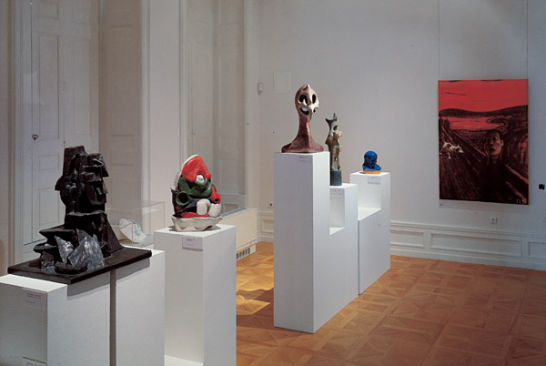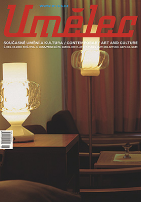| Revista Umělec 2000/3 >> The End of the World with a Question Mark | Lista de todas las ediciones | ||||||||||||
|
|||||||||||||
The End of the World with a Question MarkRevista Umělec 2000/301.03.2000 Ada Krnáčová-Gutleber | Teoría | en cs |
|||||||||||||
|
The newly renovated Kinski Palace on Prague’s Old Town Square, the headquarters of the National Gallery, has just recently opened an exhibition entitled The End of the World? General Director Milan Knížák conceived and curated the exhibition, and every critic that decides to write about it will probably run into the same problem. From what viewpoint should you evaluate an exhibition that within a conceptual framework is lacking even a hint of concept, with the exception of the vehement effort to exhibit as many works as possible, which mostly come from the National Gallery’s depository? Is it enough to simply throw together a motley assortment of what the so-called millenium of visual culture has generated, arrange everything into ideological blocks and call it an exhibition? There could be two viewpoints in which it is. The first being the view of the function and position of the National Gallery as a “stone” institution, a so-called art tomb (Adorno), and the other is in perceiving the visual arts within a contemporary context. Nevertheless, the question mark in the exhibition’s title suggests that this is precarious.
The first viewpoint is closely connected to that of General Director Milan Knížák, who correctly understood the topographical location of Kinski Palace, as opposed to its meaning. Installing the exhibition at the epicenter of the tourist ferment, the Palace will undoubtedly attract an army of visitors. Indeed, it is an amusing show that includes almost everything from Adam to microchips, everything that has ever come from an artist’s brush or computer. Visitors will thus find interesting constellations of work by Otto Guttfreund, Ivan Vosecký, Petr Pastrňák and Barbara Benish, or Silver, Josef Čapek, Otto Guttfreund, Karel Pauzer, I. Zívr, Adriena Šimotová and Naďa Rovderová, which was installed above a water hydrant, and almost impossible to detect with the naked eye. Connoisseurs adhering to the art and logic behind installing works will definitely be delighted by other innovative approaches at placing works of art in an exhibition space, such as below or high above eye level. Some of the spaces offer such combinations as a photograph by Veronika Bromová next to an installation by Jiří Příhoda and St. John the Baptist leaning on the wall, or an installation by Kateřina Vincourová juxtaposed with a painting of St. Jerome by M. Willmann, and so on, to name only a few artist clusters. The two floors of the Palace are occupied by works that find themselves in collective relationships not due to any internal causality, iconographic context or a hopefully refined concept based on detecting the artists’ thought process that inspired the works origin, but due to a simple direct proportionality stemming from the proportion of works of various techniques to the space available in the Kinski Palace. The period of origin and historical context seem to be irrelevant, as is any context or possible parallels with contemporary art. Thus, it’s mathematics. Finally, it’s an exhibition where we can safely tuck away even the slightest ambition of being confronted by challenging historical achievements in the arts. Let us then be entertained. After all, shouldn’t art also be entertaining? It certainly should, but it depends on what kind of art and on what level and what kind of institution is sponsoring all the fun. Taking into account all the benevolent sentiment for the current trend “to be entertained and entertain at any price” and the tolerance for various opinions on such approaches, something is not kosher here. Should the National Gallery take on the role of entertainer, something similar to a certain and, in the Czech Republic, extremely popular, commercial television station which does nothing to hide its superficiality in its self-declared crudeness? For the time being, the National Gallery is still a public institution and not a private one. However horrible it may sound to some, this observation invites you to move on to the second viewpoint—to wondering about how contemporary art is perceived. The exhibition currently filling Kinski Palace throughout the summer is clearly the result of the finding that art, especially visual art, has been marginalized in the world of globalization, thus it works as an illustrator within the framework of its own concept. This view, however, is as insupportable and superficial as it is incomprehensible. How should we understand the apocalypse within this concept? As an end, or, as in its original meaning, as a “revelation” or “apparition”? But a revelation of what? What does this exhibition actually reveal? The contents of the National Gallery’s depositories? On the one hand, I can understand the reluctance to verbalize visual arts that have reached a state of incomprehensibility, art for art’s sake. On the other, the thinking elements in any field are the essence and condition for development and survival. The National Gallery is no exception. An exhibition as “global” as The End of the World? does not create a conflict. It ensures a non-conflicting space in society, where the desire to orient yourself is slowly vanishing. The problem is that artists themselves, however they might try to shut themselves off or free themselves from theory and art history, are ultimately their consumers and accomplices. Paradoxically, the globalization era makes us perceive our surroundings more plastically and more intimately at the same time. One’s own identity and the identity of achievements become more important than global understatement. Despite the fact that sometimes the meaning of an art work can be deduced from the period to which it refers rather than from the period in which it was made, the space, period and thus context that determined its origin are important. This should be taken into consideration, even in this exhibition. And what about the public? Is the public important at all? It certainly is. It functions as a litmus test, not with the ambition of a critical observer but as an accomplice. The viewer is trapped in simplified perception—a show. Once again someone has succeeded in doing so. Nevertheless, it is an “interesting spectacle.” The summer program is a success. The Kinski Palace has been restored and perhaps even the museum shop will eventually offer goods normally associated with an art museum, in addition to the “typical” puppets, inherently completing the color of the Old Town Square, cheap attractions inconsiderately forced upon tourists on every other corner. Perhaps the intellectual potential of the National Gallery’s curators will be taken into account when putting together future exhibitions as, despite their decreasing numbers, there are still a few left. The institution’s reputation would only benefit. The End of the World? may not matter so much in the summer, but the fall is approaching and soon there will be fewer tourists around. Translated by Vladan Šír. The End of the World?, curated by Milan Knížák, the National Gallery, Kinski Palace, Old Town Square, Prague, May 26-November 19, 2000.
01.03.2000
Artículos recomendados
|
|||||||||||||








Comentarios
Actualmente no hay comentariosAgregar nuevo comentario